
Книги по МРТ КТ на английском языке / MRI for Orthopaedic Surgeons Khanna ed 2010
.pdf
170 III Lower Extremity
A 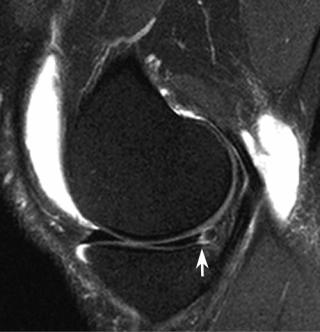 B
B
Fig. 8.7 Vertical longitudinal tear in the right knee. (A) A sagittal fatsuppressed proton-density image shows a peripheral vertical longitudinal tear (arrow) of the posterior horn of the medial meniscus. Note the e usion and Baker cyst. (B) A coronal fat-suppressed T2-weighted
image shows the vertical longitudinal tear (arrow), propagating parallel to the meniscal curvature. Note the tear of the posterior horn of the lateral meniscus (arrowhead) with an adjacent lateral tibial plateau bone bruise in this patient with an acute ACL tear.
A 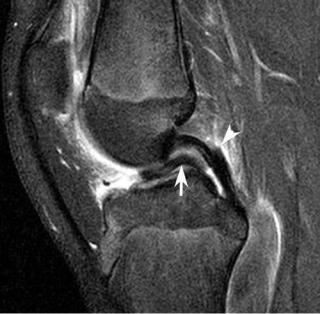
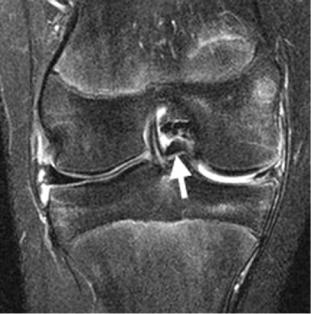 B
B
Fig. 8.8 Bucket-handle tear in the right knee. (A) A sagittal fat-sup- pressed proton-density image shows a meniscal flap (arrow), arising from the medial meniscus and displaced inferior to the PCL (arrowhead), exhibiting the double-PCL sign. (B) A coronal fat-suppressed
T2-weighted image shows a centrally displaced meniscal flap (arrow) inferior to the PCL. Note the abnormal morphology of the nondisplaced medial meniscal remnant.
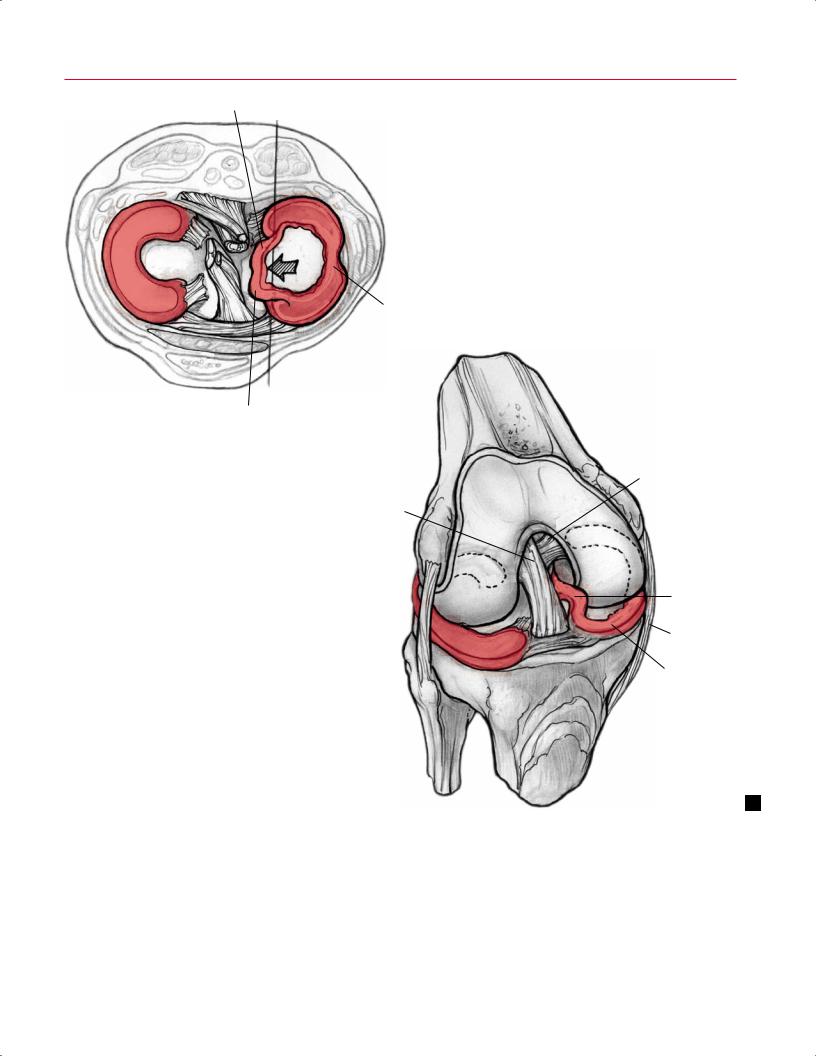
8 The Knee 171
Posterior bucket-handle fragment
Donor site of bucket-handle tear of the medial meniscus
A |
Anterior bucket-handle fragment |
PCL
ACL
Bucket handle tear (displaced)
MCL
Medial meniscus, anterior horn
Fig. 8.9 Artist’s sketches illustrating a displaced bucket-han- dle tear of the medial meniscus in the axial plane (A) and from an anterior perspective (B).
function.18 Failure to address surgically the presence of a displaced meniscal flap or fragment represents a cause of persistent joint pain and dysfunction after arthroscopy.19 Unstable meniscal tears may exhibit central or peripheral flap displacement. A typical bucket-handle tear represents a vertical longitudinal tear with central displacement of meniscal tissue. If the medial meniscus is involved, the flap is displaced inferior to the PCL, creating the double-PCL
B
sign20 (Figs. 8.8 and 8.9). Bucket-handle tears of the lateral meniscus often exhibit anterior central displacement of a flap arising from the posterior horn of the meniscus (Fig. 8.10). Displaced bucket-handle tears are a common cause of locked knee in an athlete. Posterior central flap displacement may also occur with a flap arising from the posterior horn of the medial meniscus and the displaced meniscal tissue positioned in the recess between the distal PCL and
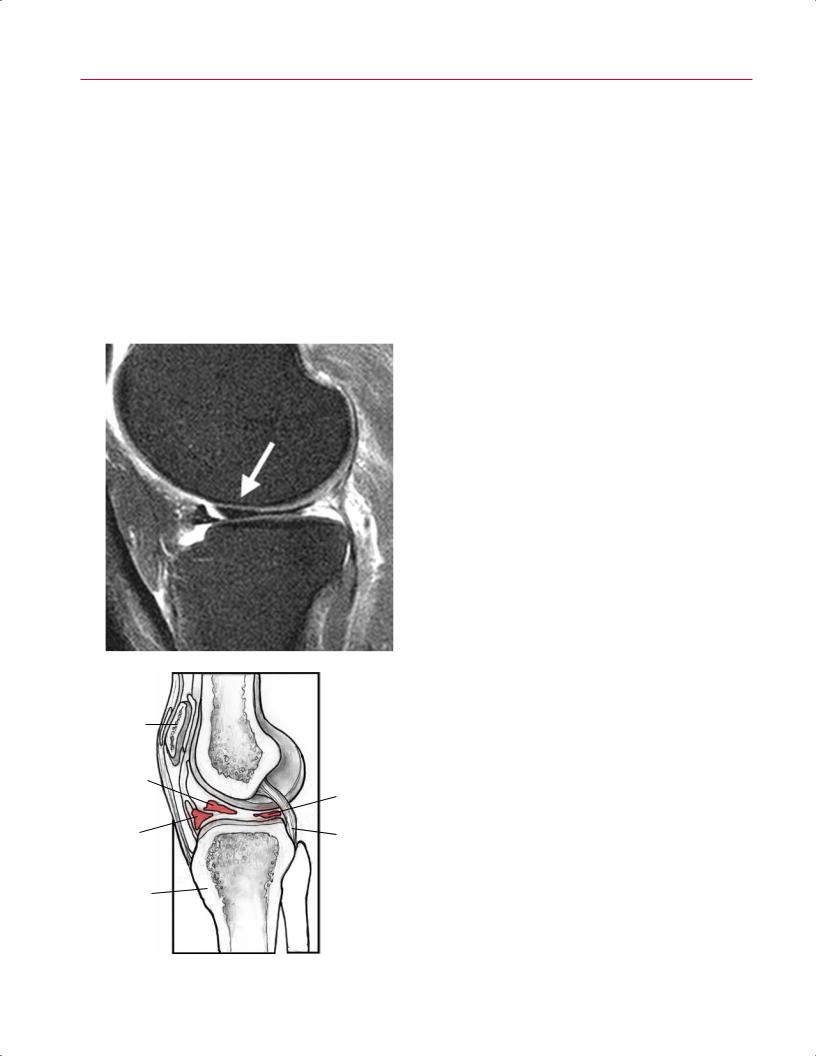
172 III Lower Extremity
the medial meniscus (Fig. 8.11). Meniscal tissue may also displace peripherally into the recess between the capsule and the femoral condyle (Fig. 8.12) or between the capsule and the tibial plateau (Fig. 8.13). Although peripherally displaced tears are less likely than centrally displaced tears to result in locking, they tend to cause adjacent capsular inflammation and osseous stress reaction, contributing to pain related to the meniscal tear. Preoperative identification and
localization of the displaced meniscal flap with MRI contribute to a more expeditious operative procedure.10
The designation of a tear as complex, based on MRI findings, implies that the tear exhibits multiple vectors or that the meniscus appears macerated and fragmented. These tears are usually unstable and, if chronic, are associated with chondromalacia and osseous stress reaction, also identified on MRI.
A
Patella
Anterior bucket-handle fragment
Anterior horn of the lateral meniscus
Tibial tuberosity
Posterior bucket-handle fragment
PCL
|
Fig. 8.10 A sagittal fat-saturated proton-density image (A) and art- |
|
ist’s drawing (B) showing anterior displacement of the posterior horn |
|
of the lateral meniscus (arrow) with the displaced flap positioned just |
B |
posterior to the anterior horn of the lateral meniscus. |
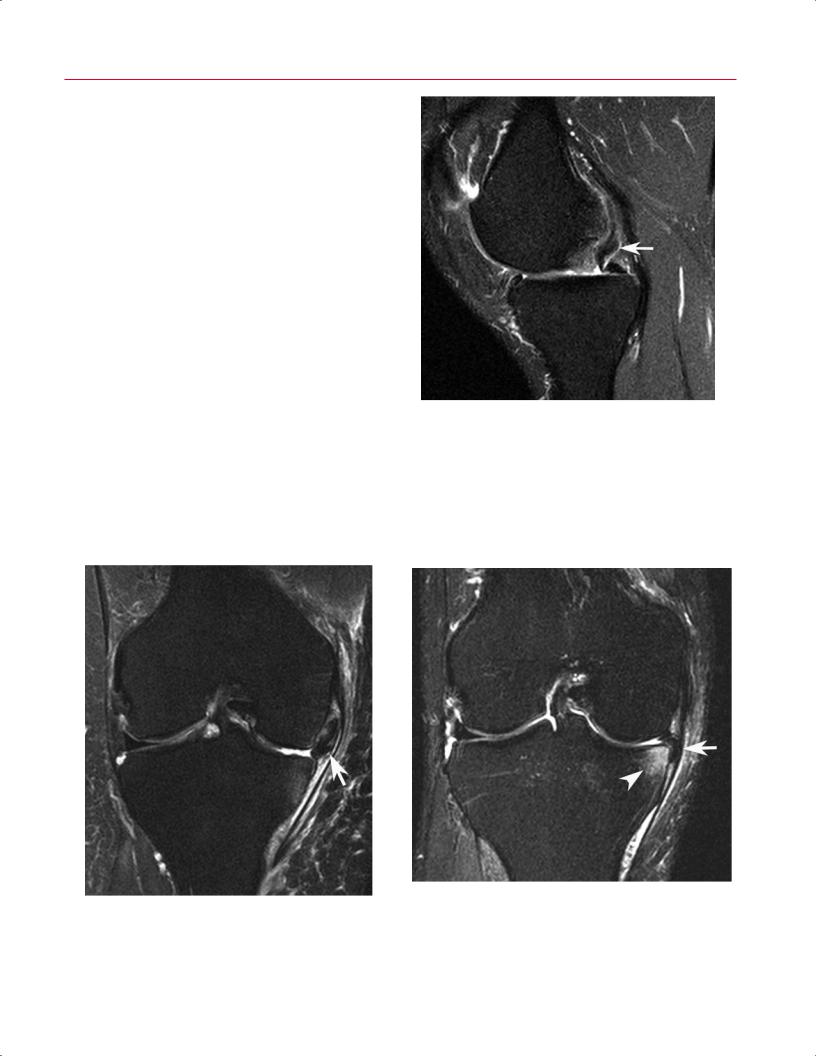
8 The Knee 173
A 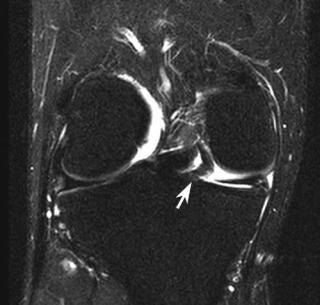 B
B
Fig. 8.11 Displaced meniscal tear in the right knee. Coronal fat-suppressed T2-weighted (A) and sagittal fat-suppressed proton-density (B) images show the posterior central displacement of a medial meniscal flap (arrow on each).
Fig. 8.12 This coronal fat-suppressed T2-weighted image of the right knee shows the peripheral superior displacement of a large meniscal flap (arrow), arising from the medial meniscus and extending into the recess medial to the medial femoral condyle.
Fig. 8.13 This coronal fat-suppressed T2-weighted image of the right knee shows the peripheral inferior displacement of a meniscal flap (arrow), arising from the medial meniscus and extending into the recess medial to the medial tibial plateau. Note the adjacent osseous stress reaction (arrowhead) and pericapsular edema.
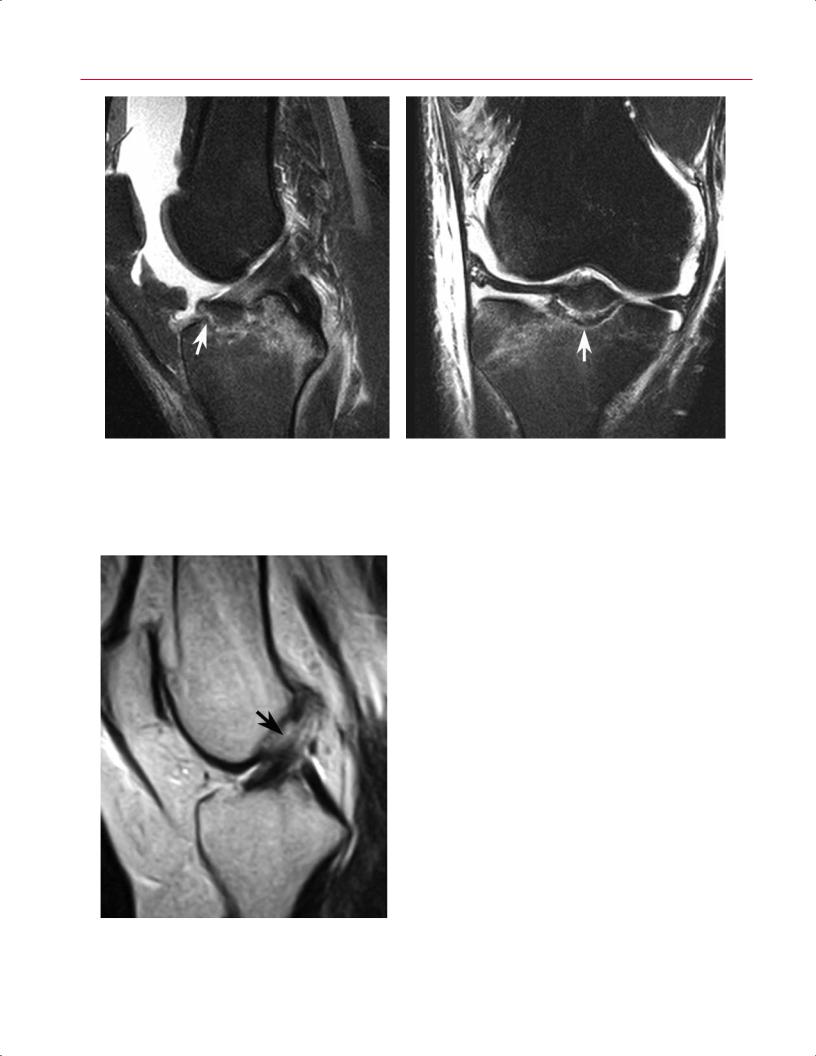
174 III Lower Extremity
A B
Fig. 8.14 ACL avulsion. Sagittal fat-suppressed proton-density (A) and coronal fat-suppressed T2-weighted (B) images of the right knee show an avulsion (arrow on each) of the tibial attachment of the ACL.
ACL Tears
|
ACL evaluation is one of the primary indications for MRI |
|
of the knee.21 The patient usually describes a noncontact, |
|
twisting or valgus injury to the knee with a planted foot |
|
and often describes sensing a “pop” inside the knee. The pa- |
|
tient may experience a subsequent lack of quadriceps func- |
|
tion because of the resulting e usion. Physical examination |
|
findings include a positive Lachman test and pivot shift. The |
|
patient’s anxiety may make the physical examination equiv- |
|
ocal, increasing the importance of the MRI. |
|
The adult ACL usually avulses from its femoral attachment |
|
or develops an intrasubstance tear. The tendon does not have to |
|
dissociate completely to become incompetent.22 The presence |
|
of blood at the femoral avulsion can appear as a “pseudomass” |
|
because of volume averaging.23 With skeletally immature pa- |
|
tients, the ACL may remain intact and avulse a fragment of |
|
bone o of the tibial attachment (Fig. 8.14). Treatment is de- |
|
termined by the degree of displacement, but it usually requires |
|
surgical fixation via arthroscopic or open techniques. |
|
The signs of an ACL injury on MRI include abnormal liga- |
|
ment signal and loss of the normal orientation and continuity |
|
of the ligament (Fig. 8.15). There are primary and second- |
|
ary signs of ACL tears as visualized on MRI (summarized in |
|
Table 8.324–26). MRI findings commonly associated with acute |
Fig. 8.15 This sagittal T2-weighted image shows a proximal ACL tear |
ACL injury include loss of ligament continuity and replace- |
(arrow). |
ment of the ligament by a poorly marginated pseudomass |

8 The Knee 175
Fig. 8.16 This sagittal fat-suppressed proton-density image shows the pseudomass appearance (arrow) of an acute ACL tear.
that shows high signal on T2-weighted imaging and low signal on T1-weighted imaging (Fig. 8.16). With both acute and chronic ACL tears, the ligament may appear abnormal in angulation, typically because of inferior displacement of the proximal portion of the ligament. Acute tears of the ACL are
Table 8.3 Signs of an ACL Tear on MRI
Primary signs
•Nonvisualization of ligament
•Complete disruption of a ligament segment
•Abnormal signal within ligament on T2-weighted images
•Alteration of normal linear configuration of ligament
•Alteration of normal angulation of ligament
Secondary signs
•Bone contusion (posterolateral and posteromedial tibia, lateral condyle of femur)
•Deepening of lateral femoral condyle notch or sulcus
•Anterior translation of tibia >5 mm from posterior margin of femoral condyle
•Buckling of the PCL (decreased angle of the PCL)
•Segond fracture
•Meniscal tear
•Posterior horn medial meniscus and tear of the lateral meniscus at the meniscofemoral ligament attachment
•Posterior displacement of posterior horn of lateral meniscus
often accompanied by bone bruises involving the posterior aspect of the lateral tibial plateau, the anterolateral aspect of the lateral femoral condyle with impaction of the articular surface notch, and the posterior aspect of the medial tibial plateau (Fig. 8.17). The osseous contusions are related to
A B
Fig. 8.17 Bone bruise pattern with ACL tear. (A) A sagittal fatsuppressed proton-density image shows a bone bruise (arrow) with osteochondral impaction involving the lateral femoral condyle and a bone bruise (arrowhead) involving the posterior aspect of the lateral
tibial plateau. (B) A coronal fat-suppressed T2-weighted image of the right knee shows bone bruises involving the posterior aspect of the lateral tibial plateau (arrowhead) and medial tibial plateau (arrow).
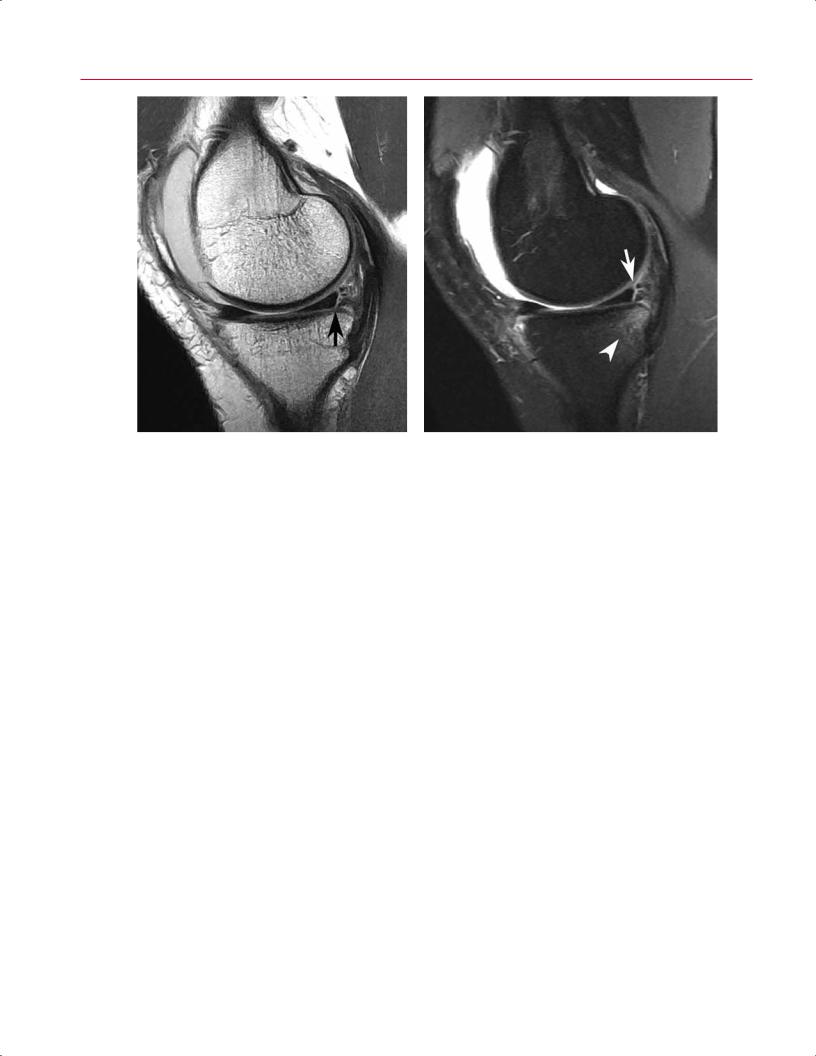
176 III Lower Extremity
A |
B |
Fig. 8.18 Medial meniscal tear with ACL tear. Sagittal proton- |
meniscus. Note the bone bruise (arrowhead on B) of the posterior |
density (A) and sagittal fat-suppressed T2-weighted (B) images show |
aspect of the medial tibial plateau. |
a peripheral tear (arrow on each) of the posterior horn of the medial |
|
the initial pivot shift rotational stress (lateral injuries) and |
indentation or notch, also called a “deepened terminal sul- |
the subsequent abrupt return to normal alignment (medial |
cus,” particularly when the patient experiences repeated in- |
plateau injury). Additional findings include anterior transla- |
stability episodes. Another sign of chronic ACL insu ciency |
tion of the tibia, resulting in increased PCL flexion, popliteus |
is buckling of the PCL, which suggests that the tibia is po- |
muscle strain, peripheral tears of the posterior horn of the |
sitioned in an anteriorly displaced position. Patients with |
medial meniscus (Fig. 8.18), and tears of the lateral menis- |
chronic ACL insu ciency also frequently develop secondary |
cus associated with the attachment of the meniscofemoral |
degenerative changes, including partialand full-thickness |
ligament (Fig. 8.19). |
chondral lesions, peripheral osteophytes, and peaking of the |
Other knee structures are also commonly injured at |
tibial spines. |
the time of ACL injury, and it is imperative that the MRI be |
When evaluating the MRI study of a patient with ACL in- |
evaluated for these concomitant injuries. These injuries, |
jury, multiple factors should be taken into consideration and |
such as meniscus tears, bone bruises, and cartilage injuries, |
included in the description of the MRI findings, including the |
not only may need to be addressed surgically, but also aid in |
location and degree of disruption of the ACL. In addition, the |
the diagnosis when the ACL tear is not obvious.27 |
collateral ligaments, PCL, and secondary restraints (includ- |
A variety of other radiographic findings seen in as- |
ing the menisci) should be carefully reviewed. It is also im- |
sociation with ACL tears are considered secondary signs |
portant to review the status of the osseous structures and |
(Table 8.324–26). A relatively small avulsion fracture seen |
articular cartilage because injuries to these structures can |
at the lateral tibial cortex (known as a Segond fracture) is |
also be treated at the time of ACL reconstruction and repair. |
caused by avulsion of the middle third of the lateral cap- |
Lastly, the condition of any tissues that might be used when |
sule28 (Fig. 8.20). |
reconstructing the ACL should be evaluated, and injury to |
When the ACL tears, the posterior tibial plateau translates |
them should be ruled out. |
anteriorly, impacting the anterior aspect of the lateral femo- |
Chronic degeneration of the ACL should be di erentiated |
ral condyle in the region of the terminal sulcus. The resulting |
from an acute ACL injury or tear. Patients with chronic de- |
contusion leaves a bone bruise pattern in these two locations, |
generation often present with chronic knee discomfort and |
best seen on T2-weighted images (Fig. 8.17). This pathologic |
a vague, nonspecific knee pain. The process is thought to be |
contact of the tibial and the femoral condyles may leave an |
secondary to repetitive low-energy microtrauma as opposed |
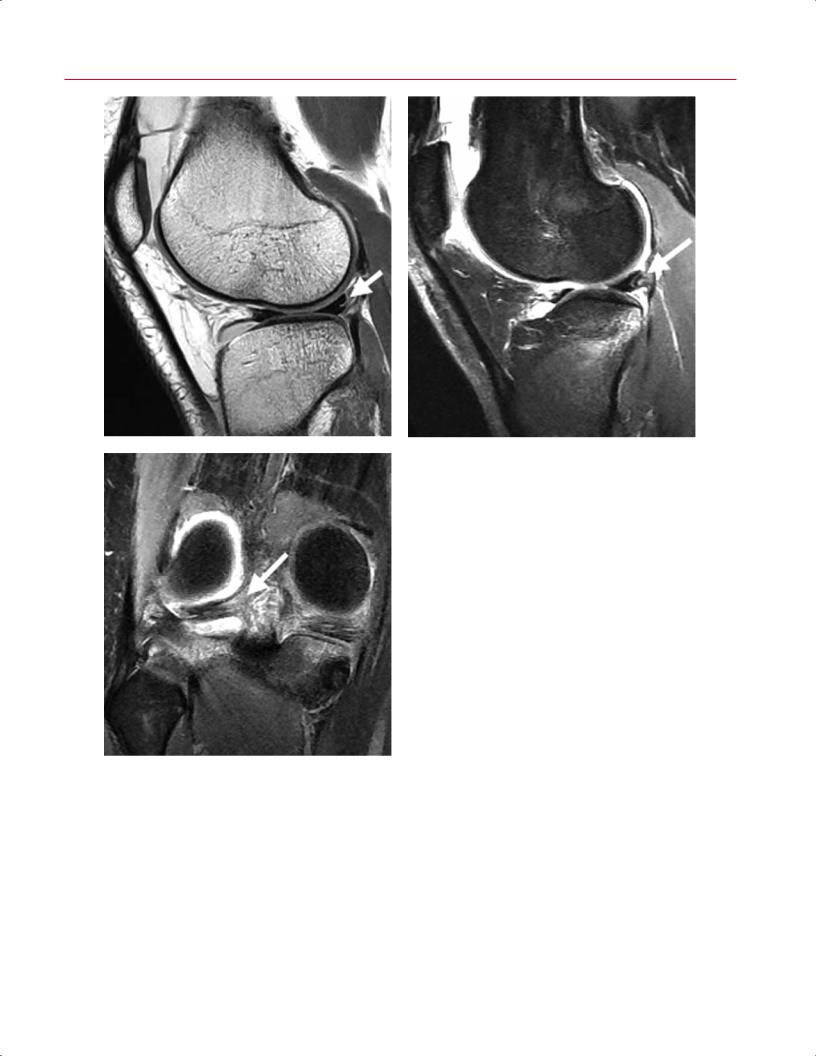
8 The Knee 177
A
C
to a single high-energy event that might produce an acute ACL tear. Minimal to no instability is seen on physical examination. The MRI may show evidence of advanced degeneration of the ACL with thickening of the ligament and less increase in T2-weighted signal than that which is typically seen with an acute tear (Fig. 8.21). Such patients also often have similar PCL involvement.
B
Fig. 8.19 Lateral meniscal tear with ACL tear. Sagittal protondensity (A), sagittal fat-suppressed T2-weighted (B), and coronal fatsuppressed T2-weighted (C) images of the right knee show a peripheral tear of the posterior horn of the lateral meniscus (arrow on each), associated with the attachment of the meniscofemoral ligament. Note the proximal tibial bone bruises, typical for an acute ACL injury.
PCL Tears
The PCL is more robust and more consistently has lower signal on MRI than does the ACL. MRI is very sensitive for tears of the PCL because of its normal low signal (Fig. 8.22). Any increased signal within the PCL on T2-weighted images is suspicious for injury.29–31 The PCL can be torn partially, indicated by increased signal on T2 images with the ligament in continuity (Fig. 8.23), or completely, visualized as a loss of
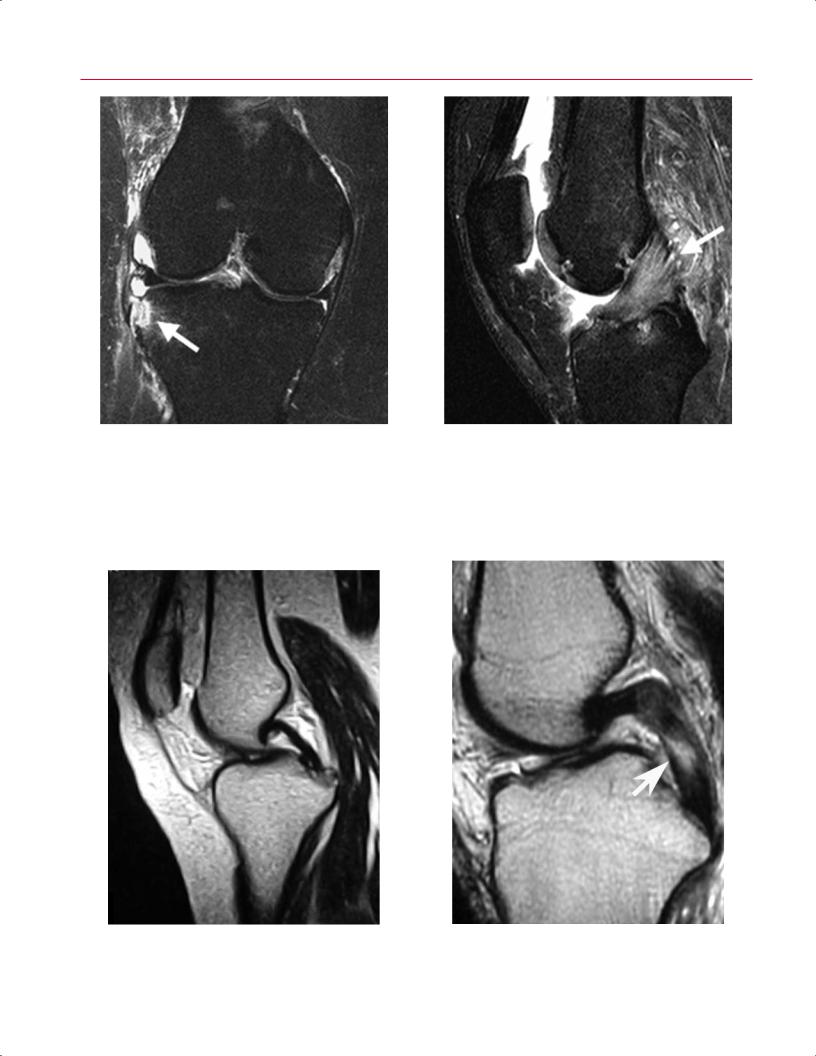
178 III Lower Extremity
Fig. 8.20 This coronal fat-suppressed T2-weighted image of the right knee shows a Segond fracture (arrow) of the lateral aspect of the lateral tibial plateau at the capsular attachment in a patient with an acute ACL tear.
Fig. 8.21 This sagittal fat-suppressed proton-density image shows advanced degeneration (marked thickening) of the ACL (arrow).
Fig. 8.22 This sagittal T2-weighted image shows a normal PCL. Note the absence of signal within the PCL.
Fig. 8.23 This sagittal T2-weighted image shows thickening and abnormal signal intensity of the PCL (arrow), corresponding to a tear.

|
|
|
|
8 The Knee 179 |
||
Table 8.4 Grading of PCL Laxity |
joint has been associated with PCL tears.32 PCL tears can be |
|
||||
|
Grade |
Description of Posterior Drawer Examination |
graded according to the amount of laxity noted on the pos- |
|||
|
|
|
|
terior drawer examination. Laxity grades of 2.5 or more usu- |
||
1.0 |
3- to 5-mm di erence in tibial step-o ; tibial plateau |
|||||
ally are associated with other knee injuries, so a high index of |
||||||
|
|
prominence remaining anterior to femoral condyles |
||||
|
|
suspicion is indicated when reviewing the MR images of such |
||||
1.5 |
6- to 8-mm di erence in tibial step-o ; tibial and femoral |
|||||
patients.33 |
||||||
|
|
condyles not yet flush |
||||
|
|
The clinician can be alerted to the amount of PCL laxity |
||||
2.0 |
9- to 10-mm di erence in tibial step-o ; anterior tibia and |
|||||
by noting the resting position of the tibia in relation to the |
||||||
|
|
femoral condyles flush with each other |
||||
|
|
femur on midsagittal images (see Table 8.433 for a summary |
||||
2.5 |
11to 13-mm di erence in tibial step-o ; anterior tibia is |
|||||
of one grading system for PCL laxity). The degree of posterior |
||||||
|
|
posterior to femoral condyles |
||||
|
|
tibial subluxation relates to the severity of the PCL insu - |
||||
3.0 |
>13 mm di erence in tibial step-o ; anterior tibia is well |
|||||
ciency. More severe PCL tears can benefit from reconstruc- |
||||||
|
|
posterior to femoral condyles; other ligamentous laxity |
||||
|
|
tion. As with ACL injuries, care should be taken to evaluate |
||||
|
|
most likely present |
||||
|
|
the MRI study for associated knee injuries. |
||||
continuity of the ligament. Bone bruises may be present, de- |
||||||
Collateral Ligament Tears |
||||||
pending on the mechanism of injury. A blow to the proximal |
Coronal images allow for optimal evaluation of collateral |
|||||
tibia from a dashboard during a motor vehicle accident can |
||||||
produce soft-tissue edema and a bone contusion involving |
ligament injury. Collateral ligament injury can be classified |
|||||
the tibial plateau, best seen on T2-weighted images. Bone |
as mild, moderate (Fig. 8.24), or severe (Fig. 8.25; Table |
|||||
bruises may be present on the anterior tibial plateaus and |
8.534,35).34 Injured ligaments should show varying amounts |
|||||
the femoral condyles if the PCL injury occurs from a hyper- |
of increased signal intensity on T2-weighted images based |
|||||
extension mechanism. |
on severity of tissue damage. |
|||||
|
It is important to note evidence for avulsion injuries or |
In general, complete MCL tears are treated nonopera- |
||||
multiple ligament injuries because both are indications for |
tively, whereas complete LCL tears are addressed surgically |
|||||
early operative repair (for avulsions) or reconstruction (for |
with early repair and later reconstruction with allograft or |
|||||
tears). A “reverse Segond” fracture on the medial side of the |
autograft. |
|||||
A 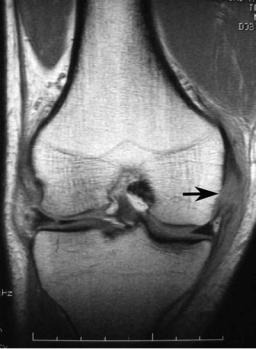
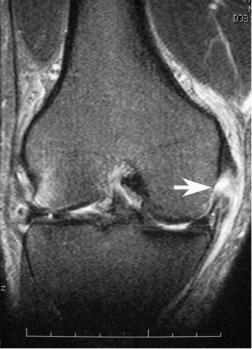 B
B
Fig. 8.24 Moderate MCL injury in the right knee. Coronal T1-weighted (A) and coronal fat-suppressed T2-weighted (B) images show a focal tear (arrow on each) of the proximal MCL. Note the corresponding impaction-related bone bruise of the lateral femoral condyle and the lateral meniscal tear.
